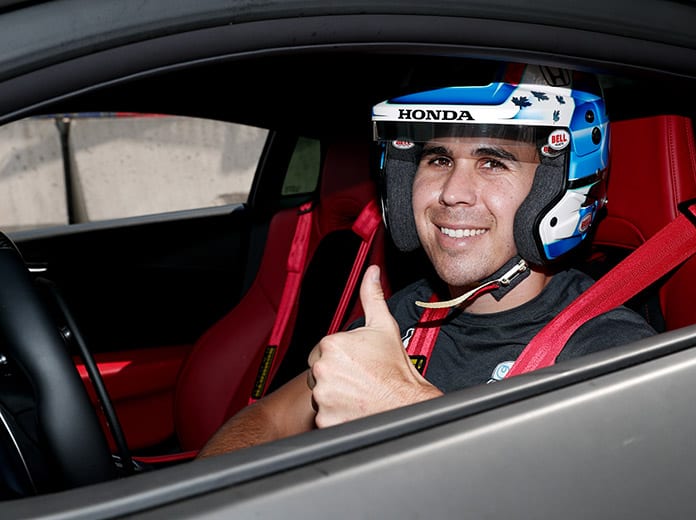MOORESVILLE, N.C. – Robert Wickens’ journey is remarkable.
After a crash during an NTT IndyCar Series race at Pocono (Pa.) Raceway on Aug. 19, 2018 left him paralyzed, Wickens promised he would dance with his wife at their wedding. He accomplished that.
Wickens also said he would take a few steps, mostly under his own power, one day. He’s done that, too.
His vow of becoming the “greatest spinal cord recovery in history,” words he said March 8, 2019, seems to be on target.
On Friday, Wickens announced he will compete in the IMSA Michelin Pilot Challenge in the GT Class for Bryan Herta Autosport, returning to race competition for the first time since his injury.
“Maybe I spoke out of turn on that one a little bit,” Wickens said in a response to a question from SPEED SPORT. “I think every recovery is remarkable in its own way. At the time, I was very motivated to return to the best ‘me’ that I could be. I’m a competitor and if I don’t give myself a level of competition, I didn’t think I would work hard enough to get to the level where I am today.
“I don’t put myself in any category above anyone else that is recovering from an injury or a setback in their life.
“It’s been quite the ride. Here we are and I’m happy to be here.”
Wickens was a former Formula 1 test driver. He joined IndyCar in 2018 and was that year’s Indianapolis 500 Rookie of the Year. But it was race No. 13 of his impressive rookie season that changed his life.
Wickens was involved in an accident on lap seven at Pocono Raceway, where he suffered a thoracic spinal fracture, spinal cord injury, neck fracture, tibia and fibula fractures to both legs, fractures in both hands, a fractured right forearm, fractured elbow, a concussion, four fractured ribs and a pulmonary contusion.
Since the accident, Wickens’ perseverance and persistence has led to triumphant breakthroughs in his relentless regimes of physical rehabilitation and therapy that continues daily.
Wickens and his team of therapists and trainers have become trailblazers in developing innovative technology and treatment methods for the spinal-cord injury community.
The No. 33 Hyundai Elantra N TCR has been fitted with a custom hand-control system designed by BHA Technical Director David Brown and Development Technician Jonathan Gormley.
The system features a custom metal ring connected to the brake pedal by a series of rods specifically tailored to the Elantra.
The ring is attached behind the steering wheel that is pulled with fingers to activate the brake.
Two linked throttle paddles and shift paddles, all attached behind the steering wheel, allow the driver to accelerate, shift and make steering inputs.
The system also features a switch for Mark Wilkins when he takes over the cockpit in pit stops that deactivates the hand throttle.
The Elantra will accelerate and brake using the traditional foot pedals when Wilkins is driving.
“Hand controls are an open book and every driver is different,” Wickens said. “The braking system will be the same as it is for Michael Johnson and that has worked very well and he has had a lot of success.”
Wickens and Mark Wilkins join the previously announced BHA driver lineup featuring six Elantra N TCR entries to defend the team’s trifecta of series titles, and they will vie for Hyundai’s third straight manufacturers’ title.
The season kicks off with the season opening test days, the Roar Before the Rolex 24, at Daytona Int’l Speedway, Jan. 21-23.
Round one of the IMPC season takes place the following weekend with the BMW Endurance Challenge, a four-hour race during the Rolex 24 Hours at Daytona race weekend on Friday, Jan. 28.
“I believe we are embarking on a brand-new chapter of my story,” he said. “I’m not just here to play around. I’m here to win races and championships for Bryan Herta Autosport.
“Aim big. Let’s go for the win. I couldn’t be in a better place. The goal is simple – try and win the thing. I was forced to leave in 2018 at the peak of my career, never felt fitter or stronger. I want to hit the ground where I left off.”
